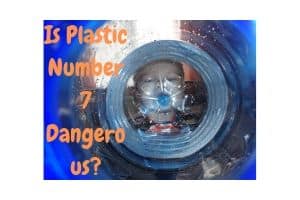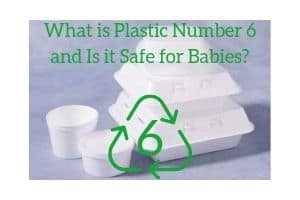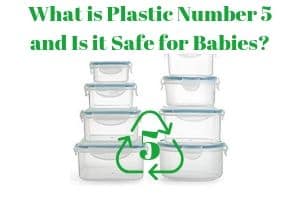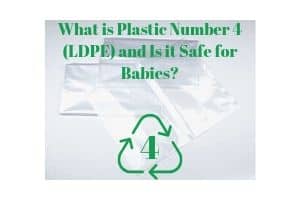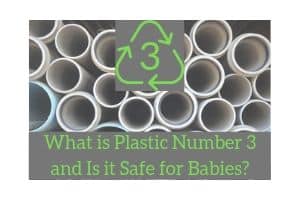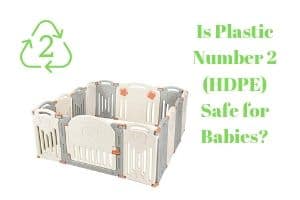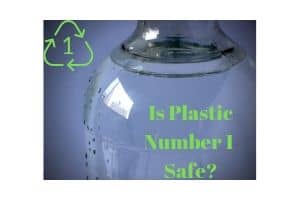Plastics are nearly unavoidable in the modern age and you’ll find them in every corner of every store you visit. Even dealing with baby products such as cups and plates, you are likely to find that plastic is the most common material. Since there is so much potential confusion about which plastics are safe I decided to take a closer look at plastic number 7 to see what it is and whether or not it’s safe for babies.
Unlike the other numbered plastic categories, plastic number 7 is the label for a group of different plastics including polycarbonate, polylactic acid (bioplastic), ABS, and TPE – some of which could contain BPA or other toxic ingredients. Some of the plastics in this group are safe for babies and some are not.
These days it can be incredibly hard to figure out whether or not your plastic products are made from safe materials or not. In my house, we try to avoid plastic as much as possible, but it’s a constant struggle. Let’s break down the mysterious plastic number 7 label and see what we can find.
Table of Contents
What is plastic number 7?
Most everyone has noticed the little numbers and triangular symbol on the bottom of plastic bottles and containers and just assumed it had something to do with recycling. In fact, these numbers are actually called resin identification codes (RIC) and they are really just meant to tell you what type of plastic the item is made from. Seeing one of them doesn’t necessarily mean that you can recycle it.
The standard for these codes is maintained by the American Society for Testing and Materials (ASTM International) and includes labels for seven different categories. While they are responsible for the codes, there is currently no regulating body that forces manufacturers to use these codes or provide more information to consumers about what they are using in their products.
Figuring out what plastic number 7 is based on these codes is almost impossible because, unlike the other labels, plastic number 7 doesn’t represent just one type of plastic. You’ll find this label on anything from baby bottles and sippy cups to CD cases and car parts.
Instead, it’s really more of a catch-all category that has been used to add new types of plastic that have been created since the numbers were created. Let’s dive into the most common types of plastic we are likely to find in this category.
The most common types of number 7 plastic
Here is a list of the most common types of plastic that you’ll find in this category and there is a big difference between some of these. Some of the items on this list can also include BPA which has been found to be incredibly harmful. This is frustrating because we should be able to identify what kind of plastic is in a product that we are buying or using easily without having to do extra homework to figure out whether or not it’s safe.
Polycarbonate (PC)
We’ll start with the worst offender on the list.
Polycarbonate is a tough, impact-resistant, and clear plastic which makes it a great choice for baby bottles and sippy cups because babies are always throwing those things on the ground! It’s also commonly found as a lining inside metal food or beverage cans.
Unfortunately, there have been many reports that containers made from polycarbonate are leaking BPA into the food and beverages inside. This is especially true when the contents are hot or the container is heated in a microwave or boiling water. As we all know by now, BPA is a harmful chemical that mimics estrogen inside the body. It has been linked to obesity, diabetes, and heart disease.
Polylactic Acid (PLA)
Swinging to the other side of the aisle, polylactic acid plastics are generally considered very safe to use.
Polylactic acid-based plastics are commonly used to make 3D printed objects, plastic bottles, and medical devices.
Unlike most other plastics, PLAs are non-petroleum based and are actually derived from renewable resources such as corn, tapioca, and other plants. Because of this, they are also fully biodegradable! This means a plastic bottle would break down sometime between six and 24 months if left floating in the ocean and a screw used in a medical procedure would stay in place for about six months while the wound heals. It’s pretty incredible stuff.
Although it’s an old study, research into the safety of PLA as a food container revealed that the only thing likely to leak into the contents was lactic acid. That’s great news because lactic acid is completely harmless and, in fact, it’s a common ingredient in food already. You probably won’t find many baby products made from this plastic on store shelves right now, but don’t worry if you do!
Acrylonitrile butadiene styrene (ABS)
ABS plastics have been around for a long time and they are generally considered quite safe.
This type of plastic is hard and tough and the best commercial example that you’re probably familiar with is Legos. Increasingly, you can also find it used in food containers and baby bottles.
The great thing about ABS plastic is that while styrene (a toxic ingredient) is used the process of manufacturing it, the final product has proven to be extremely stable. This property makes it very unlikely that it will leach anything into food or beverages it’s holding, even if the plastic is heated or you are adding hot liquids. The only issue that you can run into with ABS plastic is that you’ll sometimes find it blended with polycarbonate to make a composite. In that case, you would have to deal with the same issues you would find using PC by itself.
Acrylonitrile styrene (AS) or styrene acrylonitrile (SAN)
The other acrylic plastics AS and SAN are essentially the same thing as ABS plastic and also considered quite safe. The only real difference is that these plastics do not have butadiene added to them in the manufacturing process. This makes them a little less hard and rigid. Otherwise, they are still stable and unlikely to leach anything out into food or beverage.
Is plastic number 7 safe for babies?
If you were paying attention during the plastic lesson above, you’ll realize that this is a difficult question to answer.
For products that are made using PLA, ABS, or AS/SAN, number 7 plastic is probably safe for babies.
You will still want to do your homework on a specific product to ensure that it hasn’t been mixed with polycarbonate during manufacture or you will be in trouble. In most cases, the product will probably be labeled as BPA-free if it is free of the offending plastic. Just because it says ‘food safe’ though doesn’t mean that you can totally relax if you don’t know what it’s made from. Even the most toxic plastic used to be considered safe for food storage at one point.
Identifying which plastic you are dealing with to find number 7 plastic without BPA
If a product has the plastic number 7 logo on the bottom, there is really no way to tell which kind of plastic it is made from unless they specify it on the box. Even then, a simple description could be misleading. In nearly every case that I tried to find out a specific plastic type by looking at a product I already own or when reading the description online, I was unable to find this information.
Reputable baby brands are constantly testing their products for toxic contaminants and they should be quick to point out which materials they use, standards they meet, and other useful information. In fact, it was the baby industry itself that stopped using BPA in their products long before the FDA mentioned any official concern. To be sure, check for the BPA-free designation on the package. To truly find out what a product is made from you will likely need to search on the company’s website or email them directly.
Alternatives to using plastic baby products
Of course, if you are trying to avoid using plastics in your baby products, which is a great idea, then you should really be searching out practical alternatives for some of the most commonly used items that your baby needs. For most people, that will be sippy cups, plates, utensils, and bottles.
In all cases, there should be a glass or stainless steel alternative available that will provide a high-quality, long-lasting, and safe option for your baby’s needs.
If you are just getting into stainless steel baby products then I highly recommend checking out the Pura Kiki starter kit on Amazon. It’s a complete bottle-to-sippy cup solution that can grow with your baby. It features two stainless steel bottles and lids, 2 slow flow nipples, 2 medium flow nipples, 2 sipper spouts, and two travel covers. The nonmetal nipples and spouts are made from 100% medical-grade silicone. Check it out here, it’s a really nice deal!
Learn about the other plastic numbers
We’ve covered many details about plastic number 7 today, but there are six other categories in total. If you want to circle back to the first category, check out my recent article on plastic number 1 to learn all about polyethylene!

